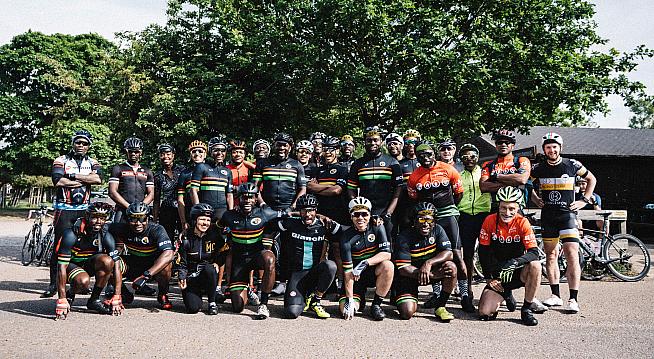When Channel 4 presenter Jon Snow observed at a Leave rally in March that he'd "never seen so many white people in one place", he attracted outrage. But look around you at your next sportive, and you may feel the same thing.
A new report, Diversity in Cycling, sheds light on some of the reasons why more Black and Ethnic Minority (BAME) people aren't getting involved in cycling. Backed by British Cycling, and with a foreword by CEO Julie Harrington, the report sets out recommendations for cycling clubs - and indeed sportive organisers - to encourage wider uptake among BAME cyclists.

Diversity in Cycling sets out to explore the experiences of BAME cyclists taking up cycling as a sport for the first time. The report began life as a grassroots project, sparked by a conversation between two friends, Andy Edwards and Mani Arthur.
A lifelong cyclist from the north of England, Andy rides with Kingston Wheelers and works in the music business where he is involved with diversity initiatives. In 2014, while racing for Sigma Sport, he competed alongside Geraint Thomas, Simon and Adam Yates and other World Tour pros in the Elite Men's National Road Race Championships as a 43 year old amateur.
Mani Arthur is an experienced club cyclist, racing road races and crits. He rides for Finsbury Park CC and is the founder of Black Cyclists Network, which aims to provide pathways for riders from diverse backgrounds to enter the sport.
The report focuses on the UK's club cycling scene and includes contributions from over 60 BAME riders, including men and women and many Muslim riders. It's an engaging and informative read. Some of the quotes from contributors are eye-opening; for example, Mani was told on his first club run that he might be better off riding with another black cyclist.
Experiences like this - although thankfully not the norm, as the report finds - are just one barrier preventing more BAME cyclists from joining cycling clubs or taking up the sport. The perception of cycling as an elite, middle class, white and male pursuit is a familiar, if untrue stereotype, given the sport's traditional base in the UK.
Some of the findings may present club riders with some helpful insights. For example, the report notes that, for some observant Muslims, fitting rides around prayer times may be an issue, while standards of modesty may make wearing Lycra problematic. In the former case, the report suggests that cycling clubs offer rides at a range of times where possible.
The aim of the report is to make cycling diverse and inclusive for all, for the benefit of the sport. The report includes examples of how increased diversity has contributed to British cycling's recent success on the world stage, and how a proactive approach from British Cycling has played a key role in identifying talent - the same talent that is currently lying undiscovered in BAME communities.
It provides a number of suggestions on how to achieve greater diversity and uptake from BAME cyclists. Key recommendations include:
-
PROMOTE VISIBILITY (BUT BE AUTHENTIC)
If your club has members from BAME backgrounds, with their permission, include those members in any visual representation of club membership. This helps make BAME participation visible to others; consider deploying ambassadors as a point of contact.
If you do not have many BAME members or none at all, do not try to be something that you are not, but do promote your values: if you are open to all newcomers regardless of race and gender say so. We all have to start somewhere, but let's make a start. -
PROMOTE ACCESSIBILITY
Many larger clubs have different rides across the week with different start times. Not everyone can make 9am on a Sunday morning. Promote a range of options.
Provide context to cycling club culture, what it means to be in a club, to ride in a group and general dos and don'ts. Clubs are intimidating, but especially so for BAME riders. -
BE INCLUSIVE
Inclusion is essential to diversity. It is not just about having BAME riders present but ensuring riders of all backgrounds feel included and visible. Work with others both within your club and the broader community to share knowledge and promote pathways. Connect with groups such as Brothers on Bikes (BoB), Black Cyclists Network (BCN) and the Women of Colour group (WOC) featured in this report and be sure these groups are aware of your club. -
TELL MORE THAN ONE STORY
Challenge stereotypes that cycling is the preserve of middle-aged middle class men in Lycra. It is not. Cycling in the UK and Europe has been traditionally a rural and working class sport that has grown so much its appeal is universal. Cycling is for everyone.
Get to know riders from BAME backgrounds, both on social media and in real life. Listen to many different stories. Visit Dr Marlon Moncrieffe's Black British Champions In Cycling exhibition and learn about these powerful stories of confronting racial barriers in cycling. -
RAISE YOUR OWN RACIAL AWARENESS
Many white people are uncomfortable talking about race. That is because most of us are not equipped to have the conversation. Read, listen and learn. If one person stands out in a group, be aware they may feel an extra level of intimidation than any other newcomer.
Be sure that person feels welcome without overdoing it. What may seem a curious encounter for you is often incredibly uncomfortable for the other person. Don't stare, smile and say hello! -
MONITOR PROGRESS
Quantify your membership through capturing ethnicity data on joining/renewal forms. Monitor progress over time. Larger clubs and organisations should certainly do this.
Some of these recommendations apply to event organisers as much as to cycling clubs. For example, the inclusion of BAME cyclists in publicity and promotional material, use of BAME cyclists as event ambassadors, and collating ethnicity data on entry forms.
Many cycling brands - Cafe du Cycliste, Velobici, Rapha, Milltag and Morvelo spring to mind - are already including BAME cyclists in their marketing. Meanwhile, the growth of groups like Brothers on Bikes (Strava) and the Black Cyclists Network (Instagram; Strava) suggest that BAME interest in cycling is alive and well, and just awaiting a welcoming, inclusive environment to thrive.
BAME cyclists have a distinguished history in the UK; the report draws attention to Black-British Cycling Champions, an exhibition that tells the story of a succession of elite level Black British riders from former pros Maurice Burton, Russell Williams and Dave Clarke, to former BC Academy rider Germain Burton, to junior national champion Charlotte Cole-Hossain.
The exhibition is the work of Dr Marlon Moncrieffe, a former racing cyclist and an academic at the University of Brighton. It was first held in December 2018 in Brighton before moving to Manchester in February 2019. There are plans to take the exhibition around the UK, and you can check it out on Instagram and Twitter.
The talent, appetite and history is all there. The next step is to make sure cyclists of all backgrounds feel welcome at cycling clubs. And hopefully, the start line at your next sportive will look a little less Snow-white...
The Diversity in Cycling report is available for download from the British Cycling website: www.britishcycling.org.uk.
0 Comments





